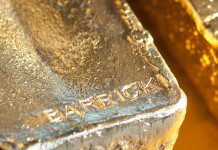
GOLD Fields CEO, Nick Holland, described the improvement in the gold price this year – which helped catapult interim share earnings to a doubling year-on-year of 18 cents – as “bittersweet”, amid the Covid-19 pandemic.
Attributable interim profit was $156m (2019: $71m) and normalised profit – from which dividends are paid – increased to $323m (2019: $126m) for the six months ended June 30. It helped the group lower net debt to $1.24bn, about half a billion dollars.
Shareholders will be rewarded with a 160 cent/share interim dividend (2019: 60 cents/share), but it could have been so much better for the company.
Gold Fields entered into group-wide oil and gold price hedging 12 months that resulted in a realised loss on the gold book of $161m at the period end.
Whilst the gold price will normalise, Gold Fields nonetheless has missed out on stratospheric pricing which is surprising given that Holland had marked himself in previous price cycles as a ‘no-hedging’ figure.
“I don’t forecast the gold price,” said Holland in a conference call today. “Our job is to figure out how to get higher gold prices into shareholder value by managing costs and, in times to come, look at new opportunities,” he said.
Despite the hedging losses, Gold Fields’ interim numbers were strong. Production was kept steady year-on-year at some 1.09 million ounces and the firm raised $250m in a rights issue for its $860m Salares Norte project in Chile and therefore avoiding partner equity as previously contemplated
Gold Fields guided to 2.2 million to 2.25 million oz for full-year production, down slightly on previous guidance of 2.26 to 2.32 million oz. It increased cost guidance to $960 to $980/oz in all-in sustaining costs (AISC) for the full-year compared to previous guidance of $920 to $940/oz, as per the group’s trading update last month.
Interim AISC came in at $987/oz (2019: $891/oz) owing to the effects of Covid-19 interruptions and community support, higher royalties and rand exchange rates.
Holland said the Covid-19 phenomenon, which had led to interruptions and three employee fatalities, would be “remembered for generations to come”. The pandemic’s bearing on Gold Fields’ production was mainly limited to South Deep in South Africa, which had a good quarter nonetheless booking $5m in positive cash flow, and Peru’s Cerro Corona where production fell about 31%.
Gold Fields’ Australian assets increased production about 14% owing to the inclusion of its Gruyere mine whilst output was 4% lower in Ghana.
Commenting on outlook, Holland said the company would take a conservative view. It is basing its upcoming reserves and resources calculation on a $1,300/oz gold price, a slight upwards revision of $100/oz, but the approach would be “… reasonably cautious as we do not know what challenges await us in the post Covid-19 world”.
Cash flow from the elevated gold price would be ploughed into debt reduction, funding Salares Norte and payout out dividends as per the group’s policy of 25% to 35% of normalised earnings.
Asked about the prospect of merger and acquisition activity, Holland said future transactions would have to be conducted on a share for share basis. This would avoid the risk of a “blowout in prices”, he said.
Gold Fields had no particular M&A targets currently. “We are watching but we have got enough on our own plates. We see growth potential in all of our mines. We think we have got production of two million to 2.5 million oz a year for the next 10 to 12 years,” he said.










